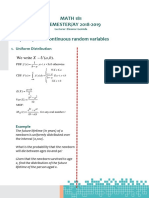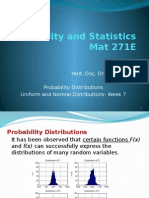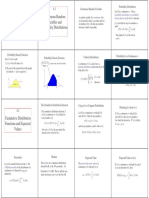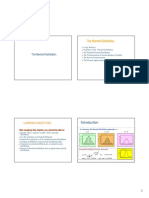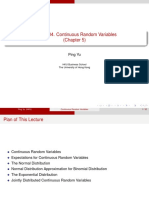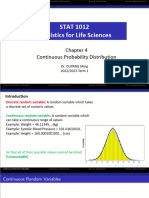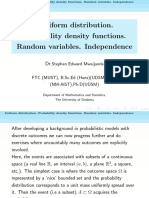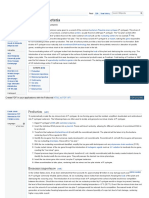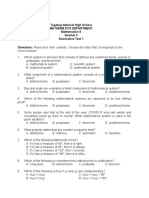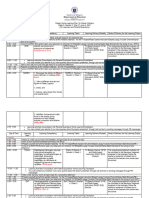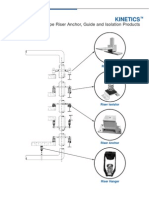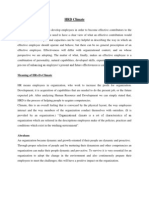Chapter-3
Analytical Models of Random
Phenomena
Useful Continuous Probability Distributions
�Continuous distributions:
Uniform
Normal
Lognormal
Exponential
Other Continuous Probability Distributions
Chi-square, Student-t and F distributions
Extreme Value Distributions
Others
�Uniform Distribution
The probability density function (PDF) for the
uniform distribution of a random variable X is
given by:
1
for a x b
f X (x ) = b a
0
otherwise
where a < b . The mean and variance are given by:
a +b
=
2
2
b
a
(
)
2 =
12
�Uniform Distribution
The cumulative distribution function (CDF) for
the uniform distribution of a random variable
X is given by:
0
x a
FX (x ) =
b a
0
for
x a
for a x b
for
x b
where a < b . The mean and variance are given by:
a +b
=
2
(b a)
=
12
2
�Uniform Distribution
The uniform distribution is very important for
performing random number generation in
simulation as will be described later in Ch. 7.
Due to its simplicity, it can be easily shown
that its mean value and variance as given
by the above equations, respectively,
correspond to centroidal distance and
centroidal moment of inertia with respect to
a vertical axis of the area under the PDF.
�PDF & CDF
fX(x)
FX(x)
1.0
F(x) =x-a/(b-a)
1/(b-a)
�Example: Concrete Strength
Based on experience, an structural engineer
assesses the strength of concrete in existing
bridge to be in the range 21 to 28 MPa.
Find the mean, variance, standard deviation
of strength of the concrete.
What is the probability that the strength of
concrete X is larger than 25 MPa?
Solution
Here we have a = 21 MPa and b = 28 Mpa
�Example: Concrete Strength (cont.)
T he m ean and variance are given by:
a + b 21+28
=
=
=24.5 M Pa
2
2
2
2
b
(
)
(28
21)
2 =
=
= 4.083 M Pa 2
12
12
= 4.083 = 2.021 M Pa
= 0.0825
cov = =
P ( X > 25 M Pa ) = 1 P ( X < 25)
25 21
= 1 F x (25) = 1
= 0.428
28 21
�Normal (Gaussian) Distribution
The probability density function (PDF) for the
normal distribution of a random variable X is
given by:
2
1
1 x
f x (x ) =
exp
- < x <
2
2
where and are the parameters of the
distribution, which are also the mean and
standard deviation, respectively, of the
variate. A short notation for this distribution is
N(,).
�Properties of Normal Distribution
fX(x) approaches 0 as x approaches either -
or +
fX(a + ) = fX(-a + ) for any a, i.e., symmetric
PDF about the mean.
The maximum value of fX(x) (the mode)
occurs at x = .
The inflection points of the density function
occurs at x = .
The density function has an overall bell shape.
The mean value and the standard deviation
are the parameters of the distribution.
�Normal PDF N( = 10, = 5).
x = -5:25;
y = normpdf (x,10,5);
plot(x,y)
N o rm a l P D F w it h m u = 1 0 . a n d s ig m a = 5
0.1
0.09
m e a n = m o d e = m e d ia n = 1 0
0.08
0.07
In fle c tio n p o in t
f(x)
0.06
0.05
0.04
0.03
0.02
0.01
0
-5
10
x
15
20
25
�Normal PDF N(10, =2.5, 5, 7.5).
0.2
0.18
((10,2.5)
0.16
0.14
f(x)
0.12
0.1
0.08
((10,5)
((10,7.5)
0.06
0.04
0.02
0
-5
10
15
20
25
�Normal (Gaussian) Distribution-CDF
The cumulative distribution function
(CDF) for the normal distribution of a
random variable X is given by:
Fx (x ) = (x ) = P(X x )
2
1
1 x
=
e xp
dx
2
2
x
- < x <
�Transformation of Normal Distribution
The evaluation of the integral of the previous
equation requires numerical methods for
each pair (, ).
This difficulty can be avoided by performing
a transformation that result in a standard
normal distribution with a mean = 0 and
standard deviation =1 denoted as S ~
N(0,1).
Numerical integration can be used to
determine the cumulative distribution
function of the standard normal distribution.
�Transformation of Normal Distribution
By using the transformation between the
normal distribution X ~ N(, ) and the
standard normal distribution Z ~ N(0,1), and
the integration results for the standard normal,
the cumulative distribution function for the
normal distribution can be evaluated using
the following transformation:
S =
�Standard Normal Distribution
The density function (PDF) and the
cumulative distribution function (CDF)
of the standard normal given,
respectively as:
1
1 2
f s (s ) =
e xp s
2
2
Fs (s ) = (s ) =
- < s <
1
1 2
e xp s ds
2
2
�Standard Normal Distribution
The results of the integral (S) are usually
provided in tables (e.g., Table A.1 of
Textbook).
Negative S values can be obtained using the
symmetry property of the normal distribution.
The table can also be used to determine the
inverse -1 of the .
For specified values that are less than 0.5, the
table can be used with
S = -1(p)= --1(1-p) for p < 0.5
.P (a X b ) = ( b ) ( a )
��Example: Concrete Strength
The structural engineer of the previous example
decided to use a normal distribution to model the
strength of concrete. The mean and standard
deviation are same as before, i.e., 24.5 MPa and
2.021 MPa, respectively.
What is the probability that the concrete strength is
larger than 25 MPa ?
25 24.5
P (X > 25) = 1 P (X < 25) = 1 (
) = 1 0.5977 = 0.400
2.021
Matlab Command
S = normcdf(25,24.5,2.021) = 0.5977
�Useful Properties of Normal Distribution
The addition of n normally distributed random
variables X1, X2,, Xn is a normal distribution as
follows: Y=X1 + X2 + X3 ++ Xn
The mean of Y is Y = X1 + X2+ X3++ Xn
The variance of Y is 2Y = 2X1 + 2X2+ 2X3++ 2Xn
Central limit theorem: Informally stated, the addition
of a number of individual random variables, without
a dominating distribution type, approaches a
normal distribution as the number of the random
variables approaches infinity.
The result is valid regardless of the underlying
distribution types of the random variables.
Any phenomenon that results from the
accumulation of many random effects tends to
have the normal distribution.
�EXAMPLE 3.7
A shell structure is resting on three supports, A, B,
and C, as shown. Even though the loads from the
roof transmitted to the three supports can be
estimated accurately, the soil conditions under A, B,
and C are not completely predictable.
Assume that the settlements A, B, C are
independent normal variates with means 2, 2.5, 3
cm and coefficients of variation 20%, 20%, 25%,
respectively.
(a) What is the probability that the maximum
settlement will exceed 4 cm?
(b) If it is known that A and B have settled 2.5 and
3.5 cm, respectively, what is the probability that the
maximum differential settlement will not exceed 0.8
cm? That it will not exceed 1.5 cm?
�EXAMPLE 3.7 (Solution)
a ) P (max > 4 cm ) = 1 P (max 4 cm )
= 1 P ( A 4 cm B 4 cm C 4 cm )
= 1 P ( A 4 cm ) P ( B 4 cm ) P ( C 4 c m )
42
4 2.5
43
= 1 (
) (
) (
)
0.4
0.5
0.75
= 1 (5) (3) (1.333) = 1 1 0.9986 0.9088 = 0.0925
b ) Since AB = 3.5 2.5 = 1, then P ( m ax 0.8 cm ) = 0
c ) For max 1.5 c m ,
if C < 1 or C > 4, then AC > 1.5cm
A lso, if C < 2 or C > 5, then BC > 1.5cm
Acceptable region
2 C 4
43
23
) (
)
0.75
0.75
= (1.333) ( 1.333) = 0.9088 0.0912 = 0.8176
P ( m ax 1.5 cm ) = P (2 C 4) = (
�Lognormal Distribution
Any random variable X is considered to
have a lognormal distribution if Y =
ln(X) has a normal probability
distribution, where ln(x) is the natural
logarithm to the base e.
In many engineering problems, a
random variable cannot have negative
values due to the physical aspects of
the problem.
In this situation, modeling the variable
as lognormal is more appropriate.
�Lognormal Distribution-PDF
The probability density function (PDF) for the lognormal
distribution of a random variable X is given by:
2
ln x
1
1
f x (x ) =
exp
2
x 2
0<x <
w here, m ean = = E (ln X ), and
standard deviation = = V ar (ln X )
1
2
= ln -
2
= ln 1 + 2
of ( ln X )
= , T he C O V
if, 0.30
A short notation for this distribution is LN(, ).
�Lognormal Distribution-PDF
x = -5:25;
y = lognpdf (x,,);
plot(x,y)
Lognormal PDF lambda=2.26
0.4
0.35
=0.1
0.3
fx(x)
0.25
=0.3
0.2
=0.5
0.15
0.1
0.05
0
10
15
20
25
�Properties of Lognormal Distribution
The values of the random variable X are
positive
fX(x) is not symmetric density function about
the mean value.
The mean value X and X are not equal to
the parameters of the distribution and .
They are related as shown in the previous
pages.
�Useful Properties of Lognormal Distribution
The multiplication of n lognormally distributed
random variables X1, X2,, Xn is a lognormal
distribution as follows: Y=X1X2X3 Xn
The mean of Y is Y = X1 + X2+ X3++ Xn
The variance of Y is 2Y = 2X1 + 2X2+ 2X3++ 2Xn
Central limit theorem: Informally stated, the
multiplication of a number of individual random
variables, without a dominating distribution type,
approaches a lognormal distribution as the number
of the random variables approaches infinity.
The result is valid regardless of the underlying
distribution types of the random variables.
Any phenomenon that results from the multiplication
of many random effects tends to have the
lognormal distribution.
�Example: Concrete Strength
The structural engineer of the previous example decided to use
a lognormal distribution to model the strength of concrete. The
mean and standard deviation are same as before, i.e., 24.5
MPa and 2.021 MPa, respectively.
What is the probability that the concrete strength is larger than
25 MPa ?
2
2
2.021
2
= ln 1+ 2 = ln 1+
= 0.00678
24.5
1 2
1
= ln - = ln(24.5) (0.00678) = 3.195
2
2
ln(25) 3.195
P (X > 25) = 1 P (X < 25) = 1 (
) = 1 0.6141 = 0.3859
0.00678
Matlab Command
S = normcdf(3.219,3.195,0.08234) = 0.6141
�Example: Concrete Strength (cont.)
The answer in this case is slightly different
from the corresponding value (0.400) of the
previous example for the normal distribution
case.
It should be noted that this positive property
of the random variable of a lognormal
distribution should not be used as the only
basis for justifying its use.
Statistical bases for selecting probability
distribution can be used as will be discussed
later in Chapter 6.
�Exponential Distribution
The importance of this distribution
comes from its relationship to the
Poisson distribution.
For a given Poisson process, the time T
between the consecutive occurrence
of events has an exponential
distribution.
This distribution is commonly used to
model earthquakes.
�Exponential Distribution-PDF & CDF
f T (t ) = e t
=0
otherwise
t
FT (t ) = P (T t ) = 1 e A &T
T = =
t 0
f T (t ) = e
t 0
=0
otherwise Matlab
t
FT (t ) = P (T t ) = 1 e
T = =
�Exponential Distribution-PDF
Exponential PDF & CDF mu = 1
x=0:0.1:5;
y1=exppdf(x,1);
y2=expcdf(x,1);
plot(x,y)
1
0.9
0.8
CDF
0.7
fx(x)
0.6
PDF
0.5
0.4
0.3
0.2
0.1
0
0.5
1.5
2.5
3.5
4.5
�Example 3.18
Historical records of earthquakes in San
Francisco, California, show that during the
period 1836-1961, there were 16
earthquakes of intensity VI or more. If the
occurrence of such high-intensity
earthquakes in this region is assumed to
follow a Poisson process, what is the
probability that such earthquakes will occur
within the next 2 years?
�Example 3.18 - Solution
No earthquake will occur in the next 10 years is
(0.12810)
P (T > 10) = 1 FT (10) = 1 (1 e
) = 0.278
Return Perriod
E (T ) = T = = 7.8 years
An earthquake of at least intensity VI can be expected, on the average,
once in every 7.8 years.
16
= 0.128 quake/years
1961 1816
FT (T = 2) = P (T t ) = 1 e (0.1282) = 0.226
In particular, for a Poisson proces, the probability of high-intensity earthquakes
occurring within the return period of 7.8 years is always
P (T < 7.8) = FT (7.8) = 1 e 1 = 0.632
�Shifted Exponential Distribution-PDF & CDF
f x (x ) = e
( x a )
x <a
=0
( x a )
FX (x ) = P ( X x ) = 1 e
T = =
x a
�Shifted Exponential Distribution-PDF & CDF
Shifted Exponential PDF & CDF
1
0.9
CDF
0.8
f(x) or F(x)
0.7
0.6
0.5
PDF
0.4
0.3
0.2
0.1
0
10
�Exponential Distribution-Remarks
The exponential distribution is useful also as a
general-purpose probability function.
The exponential distribution may be derived also
from other considerations; that is, other than as a
consequence of the Poisson process, as described
earlier.
In particular, this distribution arises, in the theory of
reliability (see Vol. II), as the model for the
distribution of life or time-to-failure of systems under
"chance" failure condition. In this connection, the
parameter is related to the mean life or mean
time-to-failure as E(T) = 1/ .
�Gamma Distribution-Erlang
If the occurrences of
an event constitute a
Poisson process, then
the time until the kth
occurrence of the
event is described by
the gamma probability
distribution.
Let Tk denote the time
till the kth event; then
(Tk t) means that k or
more events occur in
time t. Therefore, the
distribution function of
Tk is
P (X
FT k (t ) =
x =k
( t ) k 1
f T k (t ) =
(k )
E (T k ) =
= x ) = 1
x =k
e t
t 0
and V ar( T k ) =
( t ) x t
e
x!
( k ) = ( k 1) ( k )
= ( k 1) !
if k is intege r
if k is noninteger
(k ) = t
k 1
e t dt
r >0
= 0
otherw ise
S tandard gam m a pd f
f Tk
t k 1 t
e
(t ) =
(k )
= 0
t 0, r > 0
othe rw i se
�Gamma Distribution-Erlang
A&T Version
f X (x ) =
X =
(x )
k 1
(k )
Matlab version
x 0
and Var(X) = =
2
X
a1
x
f X (x ) = a
e
b (a)
x
b
x 0
X = ab and Var(X) = = ab
2
X
�Gamma Distribution-Erlang
Special Application: One can show that the time
period (or space interval) to the kth occurrence in a
homogeneous Poisson process with mean rate n has
the gamma distribution with parameter k and n .
Accordingly, the periods Xk , k=1,2,4 in the figure
all have the gamma distribution with the
corresponding k parameter values.
x1
x2
x3
x4
�Gamma Matlab - PDF
Ga mma PDF a =1,3,5 a nd b=1
1
x=0:0.1:10;
y1=gampdf(x,1,1);
y2=gampdf(x,5,1);
y=gampdf(x,3,1);
a is a shape factor
b is a scale factor
0.9
a=1
0.8
0.7
f(x)
0.6
0.5
a=3
0.4
a=5
0.3
0.2
0.1
0
10
�Gamma Matlab PDF -b scale parameter
Gamma PDF a=3 and b=1,2,5
0.35
0.3
a is a shape factor
b is a scale factor
b=1
0.25
b=2
f(x)
0.2
0.15
b=5
0.1
0.05
10
�Gamma Matlab CDF
Gamma CDF a=1,3,5 and b=1
1
0.9
0.8
a=1
0.7
a=3
f(x)
0.6
0.5
0.4
a=5
0.3
0.2
0.1
0
10
�Example: Pumps for a town water supply
At a remote pumping station two pumps are
operated so that, when there is a
breakdown, the other pump (standby) is
switched on automatically. The pumps are
identical and have a mean time between
breakdowns of 300 days.
Determine the probability density function of
the time, in days, during which the system
operates until a complete breakdown.
It is assumed that the occurrences of
breakdowns are Poisson-distributed
�Example: Pumps for a town water supply
The operating time span of a pump has PDF:
= 1 300
f X (x ) =
fX
, one pump, k = 1
( x ) k 1
(k )
e x
x0
1
( x )11 1 x
1 x
300
300
e
e
=
(x ) =
(1)
300
=0
Exponential distribution
300
x0
otherwise
�Example: Pumps for a town water supply
The performance of one pump is independent of
the other, the life of the system (sum of the lives) has
PDF
= 1300
, System= 2 pumps, k = 2
1
( z )21 1 z
1 z z
300
300
=
f Z (z ) =
e
e
300 300
(2 1)
=0
300
z0
otherwise
�Example: Pumps for a town water supply
3.5
x 10
PDF Exponential/Gamma
-3
one pump ope ra ting time span
3
2.5
f(x)
Life of the System of tw o pumps
1.5
0.5
200
400
600
800
1000
1200
x, days
1400
1600
1800
2000
�Beta Distribution
This distribution is appropriate for random variables
whose values are bounded between finite limits a
and b (interval).
1
(x a)q 1 (b x ) r 1
f X (x) =
a x b
(b a )q + r 1
B (q , r )
=0
elsewhere
where, q and r are the distribution parameters and
1
B(q,r) = xq-1 (1-x)r-1 dx
0
(q )(r )
(q + r )
q
(b a )
q +r
qr
2
(
b
a
)
x2 =
(q + r ) 2 (q + r + 1)
x = a +
1 q
(b a)
2 q r
2(r q )(b a)
=
(q + r )(q + r + 2) x
mode = a +
�Standard Beta Distribution
If a = 0 and b = 1 (0 x1.0).
A&T
1
f X (x / q , r ) =
x q 1 (1 x ) r 1
0 x 1.0
B (q , r )
elsewhere
=0
Matlab
1
f X (x / a, b ) =
x a 1 (1 x )b 1
B (a, b )
=0
0 x 1.0
elsewhere
Very versatile distribution and can be used in
diverse situations.
�Standard Beta Distribution - PDF
Standard Beta PDF
4
3.5
q= 1
r= 4
q=4
r= 2
q= r= 3
fx(x)
2.5
q = r = 1.0
2
1.5
1
0.5
0
0.25
0.5
0.75
1.2
�Standard Beta Distribution - CDF
Beta CDF
1
q= 1
r= 4
0.8
Fx(x)
q= r= 3
0.6
q= 4
r= 2
q = r = 1.0
0.4
0.2
0.25
0.5
0.75
�Example 3.23
The duration of an activity in a construction
project has been estimated by the
contractor as:
min. duration
= 5 days
max. duration
= 10 days
expected duration = 7 days
Also, the coefficient of variation of duration = 0.1
Determine the Beta distribution for the duration T of
the activity.
The probability that this activity will be completed
within 9 days.
�Example 3.23
a = 5 b = 10
q
(b a )
q +r
q
7 = 5+
(10 5)
q +r
qr
x2 =
(b a ) 2
2
(q + r ) (q + r + 1)
qr
2
(0.1 7) 2 =
(10
5)
(q + r ) 2 (q + r + 1)
q = 3.26 r = 4.89
x = a +
1
( x 5) 2.26 (10 x ) 3.89
f X (x) =
5 x 10
7.1 5
B (3.26, 4.89)
(5)
=0
elsew her e
P (T 9) = B e t a (( 9 - 5 / 1 0 - 5) , 3.26 , 4.89) = 0.9932
P (T 9) = b et acdf (.8, 3.26, 4.89 ) = 0.9932
�Example: maintenance of major roads
There are 10 major roads in State A and a
similar number and length of roads in State
B. The proportion of roads that require
substantial maintenance work during an
annual period can be approximated by
beta(4,3) and beta(1,4), respectively, in the
two states.
Which state should spend more on annual
maintenance?
What is the probability that not more than
two roads will require substantial
maintenance work in State B during an
annual period?.
�Example: maintenance of major roads
Mean number of roads that require extensive maintenance work is
10 x = 10
q
q +r
For State A should spend on = 10
4
= 5.71 6 roads
4+3
1
=2.00 roads
1+ 4
State A need to spend more .
For State B = 10
q =1
fX
r =4
1
( x ) 0 (1 x ) 3
(x) =
B (1, 4)
1
P (T 2) = F (0.2) =
0.2
0 x 1.
f X (x) dx =
1
B (1, 4)
0.2
(1 x ) 3 dx
0.2
3x 2 3x 3 x 4
3
0 (1 x ) dx = 4 x 2 + 3 4 = 0.59
0
P (T 9) = betacdf (.2 ,1, 4 ) = 0.59.
(1 + 4)
=
(1) (4)
0.2
�Other Continuous Probability Distributions
These distribution are classified as
Distribution used in statistical analyses
Student-t, or t Distribution
F Distribution
Chi-square ( 2) Distribution
Extreme Value Distribution
Type I
Type II
Type III
�2 Distribution
The 2 distribution is a special case of the gamma
distribution where b = 2 and a = n/2 in the equation for
gamma distribution.
The 2 distribution gets special attention because of its
importance in normal sampling theory.
x
x f / 21
f X (x ) = f / 2
e 2
2 ( f 2)
/ 2 1
x
2
x
f X (x ) = / 2
e
2 ( / 2)
or f degrees of freedom
x = = f ,
2 = 2 = 2f
x
x0
x0
�2 Distribution chi2pdf(x,f)
Chi-squa re PDF
1
f =1
fx(x)
0.75
0.5
f= 4
f= 8
f = 12
0.25
10
15
�2 Distribution
This distribution is frequently encountered in statistical analysis,
where we deal with the sum of squares of n random variables
with standard normal distribution
2 = C = Z 12 + Z 22 + Z 32 + ....Z n2
Where C = random variable with chi-square, and Z1 to Zn are
normally distributed (standard normal)
This distribution is positively skewed with a shape that depends on the
parameter f.
It is of interest in statistical analysis to determine the percentage
points x,f that correspond to the following probability:
= P ( X x ,f ) =
x ,f
f x (x )dx
These percentage points are provided in Table A.3 of Appendix A.
�Student-t, or t Distribution
The student-t or t distribution is a symmetric, bellshaped distribution with the following density
function:
( f + 1) / 2 t
f T (t ) =
1 +
f (f / 2) f
2
- <t <
Where f = n-1 is the degree of freedom.
The mean and the variance are for f > 2
T = 0,
( 1 )( f +1)
2
f
=
f 2
2
T
t/2,f is the value of the variate T at the cumulative
probability (1-/2) and tabulated in Table A.2.
�Student-t, or t Distribution
As f increases toward , the variance of the t
distribution approaches unity, and therefore it
approaches the standard normal distribution N(0,1).
It is of interest in statistical analysis to determine the
percentage points t/2,f that correspond to the
following probability:
1 = P (T t / 2,f ) =
t / 2 ,f
f T (t )dt
These percentage points are provided in Table A.2 of
Appendix A.
�t Distribution PDF - tpdf(x,f)
Student t-distribution PDF
f(t)
0.5
f = 15
f = inf
N(0,1)
f= 5
f =2
0.25
0
-5
-4
-3
-2
-1
�F Distribution
The F distribution has a natural relationship with the 2
distribution. If X1 and X2 are both 2 with n1 and n2
degrees of freedom respectively, then the statistic F
below is F distributed. The two parameters, n1 and n2 ,
are the numerator and denominator degrees of
freedom.
2
F ( 1 , 2 ) =
1
2
2
The F distribution has two shape parameters n1 = k
and n1 = u, and has the following PDF:
f F (f ) =
u + k k
2 u
k
2
(f )
k
1
2
fk
(u / 2 ) (u / 2) + 1
u
u +k
2
f >0
�F Distribution
The distribution is positively skewed with a shape that
depends on k and u.
It is of interest in statistical analysis to determine the
percentage points f,k,u that correspond to the
following probability:
= P (F > f ,k ,u ) =
f ,k ,u
f F (x )dx
The percentage points are usually provided in Tables.
The F distribution has a unique property that allows
tabulating values for the upper tail only.
For the lower tail, the following relation can be used to
find the percentage points: f1-,k,u=1/ f,k,u
f,k,u f,u,k
�F Distribution - fpdf(k,u)
F-distribution PDF(k,u)
0.8
0.7
0.6
F(5,10)
0.5
f(f)
F(5,5)
0.4
F(5,3)
0.3
F(5,1)
0.2
0.1
0
10
�Extreme Value Distributions
In many engineering applications, the
extreme values of random variables are of
special importance.
The largest or smallest values of random
variables may dictate a particular design.
Wind speeds, for example, are recorded
continuously at airports and weather
stations.
The maximum wind speeds per hour, month,
day, year, or other period can be used for
this purpose
�Extreme Value Distributions
Usually, the information on yearly maximum
wind speed is used in engineering
profession.
If the design wind speed has a 50-year
return period, then the probability that the
wind speed will exceed the design value in
a year is 1/50 = 0.02.
Design of earthquake loads, flood levels,
and so forth are also determined in this
manner.
�Extreme Value Distributions
In some cases, the minimum value of a
random variable is also of interest for design
applications.
For example, when a large number of
identical devices, such as calculators or
cars, are manufactured, their minimum
service lives are of great interest to
consumers.
In constructing an extreme value
distribution, an underlying random variable
with a particular distribution is necessary.
�Extreme Value Distributions
If different sets of samples are obtained
(through physical or numerical
experimentation).
One can select the extreme values from
each sample set, either the maximum or the
minimum values, and then construct a
different distribution for the extreme values.
Therefore, the underlying distribution of a
variable governs the form of the
corresponding extreme value distribution.
�Engineering Significance of Extreme Values
In structural reliability and safety, the
maximum loads and low structural
resistance are the values most relevant to
assure safety or reliability of a structure.
The prediction of future conditions is often
required in engineering design, and may
involve the prediction of the largest or
smallest value.
Therefore, extrapolation from previously
observed extreme value data is invariably
necessary.
The asymptotic theory provides a powerful
basis for developing the required
engineering information.
�Type I Extreme Value Distributions
Two forms of the Type I extreme value distribution
can be used:
1- The largest Type I extreme value(PDF):
f X n (x ) = ne
n ( x u n )
e n ( x u n )
CDF is given by
FX n (x ) = e
e n ( x u n )
2
= un +
and X = 2 ( = 0.577216)
n
6 n
2
�Type I Extreme Value Distributions
2 The smallest Type I extreme value
f X 1 (x ) = 1e
1 ( x u1 )
e 1 ( x u1 )
CDF is given by
FX 1 (x ) = 1 e
e 1 ( x u1 )
2
= u1
and X = 2 ( = 0.577216)
1
61
2
�Applications of Type I Distribution
Strength of brittle materials can be
described by Type I smallest value.
Hydrological phenomena such as the
maximum daily flow in a year or the
annual peak flow hourly discharge
during flood.
Wind maximum velocity in a year.
�Example: Type I Largest
The data on maximum wind velocity
Vn at a site have been compiled for n
years, and its mean and standard
deviation are estimated to be 61.3
mph and 7.52 mph, respectively.
Assuming that Vn has a Type I extreme
value distribution, what is the
probability that the maximum wind
velocity will exceed 100 mph in any
given year?
�Example: Type I Largest
The parameters un and n can be calculated as
2
2
=
= 0.17055
n =
2
2
6 X
6(7.52)
n
X = u n +
u n = 61.3
0.577216
= 57.9157
0.17055
The probability that the maximum wind velocity is
greater than 100 mph is
P (X
> 100) = 1 F ( X
= 1 F X n (100) = 1 e
= 100)
e 0.17055 (100 57.9157 )
= 0.000763
�Example: Type I Largest
Suppose that in the previous example the design
wind speed with a return period of 100 years
needs to be estimated for a particular site.
With Vd denoted as the design wind speed to be
estimated, the probability that it will be
exceeded in a given year is 1/100 = 0.01. Thus,
P ( X n >V d ) = 1 F ( X n =V d ) = 0.01
1 FX n (V d ) = 1 e
V d = 84.89 mph
e 0.17055(V d 57.9157 )
= 0.01
�The Type II Extreme Value Distribution
Largest
k n
n y
CDF is given by
k +1
fY n (y ) =
FY n ( y ) = e
n
y
n
y
y 0
1
= n 1
k
2
1
2
= n 1 1
k
k
2
1
k
COV =
1
1
2 1
k
2
Yn
for k > 2
�The Type II Extreme Value Distribution
Smallest
k 1
fY1 (y ) =
1 y
CDF is given by
FY 1 ( y ) = 1 e
1
y
k +1
1
y
y 0
2
1
Y2 = 12 1 2 1
k
k
Y = 1 1
1
k
COV =
1
1
2 1
k
for k > 1
for k > 2
�The Type III Extreme Value Distribution
Largest
CDF is given by
k
f Z n (z ) =
w n
FZ n (z ) = e
w n
w n
Z = ( w n ) 1 +
n
Z2 = ( w n ) 2 1 +
n
k 1
1
k
1
COV =
1
2 1
k
2
1
2
1
k
k
�The Type III Extreme Value Distribution-Weibull
Smallest:
Most useful applications of this model deal with smallest values.
w
1
CDF is given by
k
f Z 1 (z ) =
w1
FZ 1 ( z ) = 1 e
w 1
Z2 = (w 1 ) 2 1 +
1
w 1
Z = + (w 1 ) 1 +
1
k 1
1
k
1
COV =
1
2 1
k
2
k
+
1



